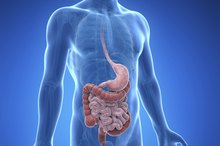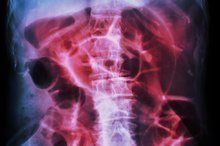Symptoms of a Partial Bowel Blockage
A partial bowel blockage, also called a partial bowel obstruction, is a condition in which your intestines are partially blocked. This blockage can stop or slow the passage of fecal material through your bowels. If you have a pre-existing condition such as an abdominal surgery, cancer, diverticulitis, adhesions or use large daily quantities of narcotics, you could be a candidate for a partial bowel blockage, Journal Watch.org says 2. Progression to a complete bowel obstruction could be life threatening. Knowing signs and symptoms of a partial bowel blockage allows you to identify the problem before it reaches that severity.
If you are experiencing serious medical symptoms, seek emergency treatment immediately.
Abdominal Signs
Abdominal pain is a vague symptom of many medical problems, including a partial bowel blockage. When the bowel is partially blocked, intestinal contents start to back up. This can cause pain and abdominal cramping, as well as distention and bloating, the National Institutes of Health says. Distention is an uncomfortable swelling in your abdomen, which you may notice because your clothes feel tighter. A rigid or firm abdomen in the absence of musculature is a late sign of blockage and requires immediate medical attention.
- Abdominal pain is a vague symptom of many medical problems, including a partial bowel blockage.
- Distention is an uncomfortable swelling in your abdomen, which you may notice because your clothes feel tighter.
Nausea and Vomiting
Blocked Duodenum Symptoms
Learn More
Appetite decreases when food isn't moving properly through your intestines. You may feel full after eating a very small amount, and can become nauseated easily with intake. Even when you don't eat foods that cause high gas production, such as raw vegetables, you may pass large amounts of flatus, the National Institutes of Health says. The materials that are partially blocking your intestines produce a large amount of gas as a byproduct of sitting there, undigested, which can elicit nausea. Vomiting is a poor sign with bowel obstructions, and may indicate that your partial obstruction is getting worse. When the food you eat can't pass the partial bowel obstruction, it can back up through your digestive tract. Vomiting with partial bowel obstructions is largely dependent upon the location of the blockage, the severity, and your food intake.
- Appetite decreases when food isn't moving properly through your intestines.
- The materials that are partially blocking your intestines produce a large amount of gas as a byproduct of sitting there, undigested, which can elicit nausea.
Constipation and Diarrhea
Prolonged constipation and diarrhea are signs of a partial bowel obstruction 2. Constipation occurs when the substances can't pass the blockage and continue to progress through your intestines. However, with a partial blockage, some food substances make the trip, in the form of small amounts of pure liquid stool. It's possible to be constipated and have diarrhea, if you define diarrhea as having liquid stool. These small liquid stools continue indefinitely until the partial blockage is resolved, and the entire contents can again pass through your intestines uninhibited.
- Prolonged constipation and diarrhea are signs of a partial bowel obstruction 2.
- These small liquid stools continue indefinitely until the partial blockage is resolved, and the entire contents can again pass through your intestines uninhibited.
Related Articles
References
- National Institute of Health. Medline Plus: Intestinal Obstruction
- Large, Bowel, Intestinal, Obstruction I Cleveland Clinic. Cleveland Clinic. Updated May 31, 2017.
- Intestinal Obstruction - Gastrointestinal Disorders - MSD Manual Professional Edition. MSD Manual Professional Edition. Updated December 2018.
- Ileus I. Intestinal obstruction and Ileus: MedlinePlus Medical Encyclopedia. Medlineplus.gov. Updated October 2, 2019.
- Acute Perforation of the GI Tract - Gastrointestinal Disorders - MSD Manual Professional Edition. MSD Manual Professional Edition. Updated December 2018.
- Catena F, De Simone B, Coccolini F, Di Saverio S, Sartelli M, Ansaloni L. Bowel obstruction: a narrative review for all physicians. World Journal of Emergency Surgery. 2019;14(1). doi:10.1186/s13017-019-0240-7
- Sherman K, Wexner S. Considerations in Stoma Reversal. Clin Colon Rectal Surg. 2017;30(03):172-177. doi:10.1055/s-0037-1598157
- Lai H, Wu K, Liu Y, Zeng Z, Zhang B Fluoroscopy-guided long intestinal tube placement for the treatment of malignant bowel obstruction.Oncol Lett. 2019 Jun;17(6):5154-5158. doi: 10.3892/ol.2019.10151. Epub 2019 Mar 15.
- Lee MJ, Sayers AE, Drake TM, Marriott PJ, Anderson ID, Bach SP, Bradburn M,et al. National prospective cohort study of the burden of acute small bowel obstruction.BJS Open. 2019 Feb 22;3(3):354-366. doi: 10.1002/bjs5.50136. eCollection 2019 Jun.
Writer Bio
As a bachelor's-prepared registered nurse with more than 15 years of diversified experience, Juliet Wilkinson innerves our health-conscious population through expert articles. She is a motivated professional who believes that preventive care is the first step towards health and well-being.









